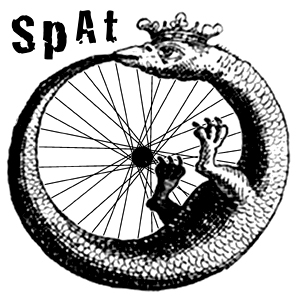1998. After I hand-woven a train for a railway station in Norway, I am preparing to emigrate to Norway. Mr. Diseperati (Mr. "Hopeless"), which has an art gallery in the Hotel Saturnia (VIP thermal baths), he offers me a show in that hotel. Daniel Spoerri is invited to the inauguration, so he approves my project of Global Home. Then I no longer migrated to Norway.
Thursday, June 10, 2010
Wednesday, June 09, 2010
Global Home, 2000
My nomadic weaving workshop reaches Goerlitz, the easternmost city of Europe at that time. I camp in the monumental cemetery and teach absolute beginners to weave with any recyclable fiber.
More about: "Global Home"
Music: Mieczlaw Litwinsky, Saba Litwinska (Sol et Luna)
Poetry: Andreas Blochwitz
Video clipping from: Artemision Project.
Video Author: Weslaw Kleszcz
Monday, June 07, 2010
Meeting today a page
 Meeting today a page written by S.B. Dissanayake for my exhibition "Textile Appetizers" in Colombo, Sri Lanka, in 1996.
Meeting today a page written by S.B. Dissanayake for my exhibition "Textile Appetizers" in Colombo, Sri Lanka, in 1996.This page is a dear memory for me. I was directed to Professor Dissanayake by Tilak Samarawickrema. The Professor was in a cottage outside Kandi, hills, surrounded by tropical jungle. I found him kindly droving away the monkeys that had invaded the studio, messing his objects of ancient art and modern. He was an elderly gentleman, careless and smart, British-style. But he still retained the warm and cosmic smile that distinguishes the Sinhalese people.He watched my photos, let me talk about my work, taking notes with a fountain pen. He had some questions, all sharp and quite specific. Then he sent his page in a letter.
I generally do not have much esteem for art critics, especially the Italians. I, however, I have a real reverence for Dissanayake, not only because he wrote quite well of my work... but also because he wrote with great simplicity, that reminds me of Bruno Munari. But he was even prophetic in the sentence:
"He is an artist who has, to my mind, committed himself to a cause: that of education, in addition to avant-guardism."
S. B. DISSANAYAKE
(August 96)
THE WEAVER'S CRAFT AND ART BY LUCIANO GHERSI
Luciano Ghersi is a weaver whose preoccupations are those of all modern twentieth century artists: extending the subject matter of art, extending the materials you can make it from, and new applications of old skills. With a singular strength of will in his work, arrived at only by a conscious clarity and the full possession of the resources of his craft, he achieves a refined elegance in matters of taste in his creations, and, their display. It is a quality which defines purity, in painting as in weaving. Luciano Ghersi has no mind to speculate on 'sentiment' or introduce 'ideas', until the 'sentiment' and the ideas' have been skillfully and subtly organized. Some of his large-scale works are skillfully displayed in public places (the 'Poncho' draped on the neoclassical sculpture in a town square, and his tapestries on the city wall announcing a weaver's workshop) both shock and inspire; they dominate and triumph in their purpose.
In many of these works, his purpose seems to me, is to present life and things human (human detritus for example) just as they are. It is a purpose and program not without a certain ingeniousness, but their positive merit, it seems to me, is to have found, or rather, to have introduced, poetry, and sometimes the purest poetry, in things or themes, which until now have been considered base or insignificant. But in the world of art, there is no subject or material which the artist's handiwork cannot ennoble or debase, render disgusting or delightful: nothing is too solid, or heavy, or too strong for him; or, from an artistic point of view, too explicit. The artist is eager to wield (thorough, in Luciano's case, woven things) an influence on society, on ordinary people and craftsmen alike. It is his anxiety to reach an aim quite other than that of mere entertainment which distiguishes Luciano Ghersi from most post-modern artists. He is an artist who has, to my mind, committed himself to a cause: that of education, in addition to avant-guardism.
The real presence of things in his work; barb-wire, human detritus from beaches, plastic, rope, bits of fish-net etc. are intellectual transpositions which the weaver's craft has achieved in transforming into art. It is, Luciano Ghersi's way of looking at and handling the world around him, by the individual operations of his hand and his eye, with which, he transforms his individual act of seeing into a thing seen and to be looked at by us. His works absorb, dismiss and consume our sense of surprise, replacing the modern question of how it was done, in the same way as music can sometimes so enchant us that the very existence of sounds is forgotten.
Saturday, June 05, 2010
Subscribe to:
Posts (Atom)






